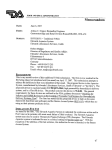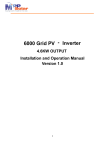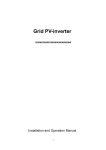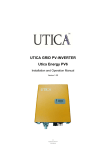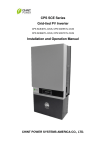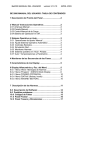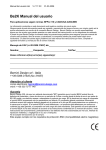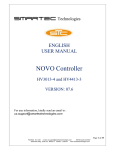Download CMS 2000 - Greenforce Solar
Transcript
CMS2.0 kW Grid PV-Inverter Installation and Operation Manual Version 1.0E 2008.09 Contents: Before you start….................................................................................................... 3 Safety instructions ................................................................................................... 4 Limited Warranty..................................................................................................... 6 1. Overview ......................................................................................................... 7 2. Features.......................................................................................................... 8 3. Installation instructions................................................................................. 9 Opening the package ............................................................................... 9 Before installation ..................................................................................... 9 Mounting Inverter to the wall .................................................................. 11 Connecting to the grid (AC utility)........................................................... 14 Connect to PV Panel (DC input)............................................................. 15 Checking................................................................................................. 16 4. System Diagram ........................................................................................... 17 5. Operating Your PV-Inverter......................................................................... 18 Modes of operation................................................................................. 18 Front Panel arrangement ....................................................................... 18 Front Panel ............................................................................................. 19 Maximum Power Point Tracking (MPPT) ............................................... 22 Accuracy of the reading.......................................................................... 22 Edition 1.0E 2008/09 1 6. Inverter Status.................................................................................................. 23 Display information ................................................................................. 23 LED......................................................................................................... 25 7. Communications.............................................................................................. 26 8. Trouble shooting.............................................................................................. 28 9. Specifications................................................................................................... 30 Electrical ................................................................................................. 30 Edition 1.0E 2008/09 2 Before you start… Congratulations on choosing CMS2.0 kW Grid PV-Inverter, a product from CMS. 2.0 kW Grid PV-Inverter is a highly reliable product due to its innovative design and perfect quality control. Such an inverter is used in high demand, grid-linked PV systems. This manual contains important information regarding installation and safe operation of this unit. Be sure to read this manual carefully before using. If you encounter any problems during installation or operation of this unit, first check this manual before contacting your local dealer or representative. Instructions inside this manual will help you solve most installation and operation difficulties. Thank you again for choosing our product. Please keep this manual handy for quick reference. Start enjoying your Inverter and your life! Edition 1.0E 2008/09 3 Safety instructions Risk of Electric Shock 1. Do not remove the casing. Inverter contains no user serviceable parts. Refer servicing to qualified service personnel. Both AC and DC voltage sources are terminated inside the PV-Inverter. Please disconnect these circuits before servicing. 2. When a photovoltaic panel is exposed to light, it generates a DC voltage. When connected to this equipment, a photovoltaic panel will charge the DC link capacitors. 3. Energy stored in this equipment’s DC link capacitors presents a risk of electric shock. Even after the unit is disconnected from the grid and photovoltaic panels, high voltages may still exist inside the PV-Inverter. Do not remove the casing until at least 30 minutes after disconnecting all power sources. 4. This unit is designed to feed power to the public power grid (utility) only. Do not connect this unit to an AC source or generator. Connecting Inverter to external devices could result in serious damage to your equipment. 5. Carefully remove the unit from its packaging and inspect for external damage. If you find any imperfections, please contact your local dealer. Edition 1.0E 2008/09 4 Hot surfaces Although designed to meet all safety requirements, some parts and surfaces of Inverter are still hot during operation. To reduce the risk of injury, do not touch the heat sink at the back of the PV-Inverter or nearby surfaces while Inverter is operating. Edition 1.0E 2008/09 5 Limited Warranty Inverter comes with a limited warranty. This warranty includes all defects of design, components and manufacturing. Excluded from warranty are damages due to: Breaking the product seal (opening the casing) Improper transportation and delivery Unqualified persons opening the unit Improper installation Unauthorized modification, testing or repairing Use and application beyond the definition in this manual Application beyond the scope of safety standards (AS4777&AS3100 etc.) Acts of nature such as lighting, fire, storm etc. The right to repair and/or replace the unit is at the manufacturers’ discretion. Any damages discovered during installation should be submitted via a written damage report within 5 working days of receiving the PV-Inverter. Otherwise not responsible for damages beyond the scope of this warranty. Edition 1.0E 2008/09 6 1. Overview CMS2.0 kW Design Overview Front View Bottom View Parts Description Edition 1.0E 2008/09 7 2. Features Very high conversion efficiency (>96%) MPPT (Maximum Power Point Tracking) Higher power capacity than similar products of the same size. Embedded LCD display showing complete status information Natural convection cooling. Quiet, fan-less design Stylish, modern casing Compact, small profile High reliability, and Easy to install Maintenance free Standard RS-232, optional RS-485 and others Embedded ENS meets AS3100&AS4777 No external GFCI breaker is required Edition 1.0E 2008/09 8 3. Installation instructions Opening the package After opening the package, please check the contents of the box. It should contain the following: 1. One CMS2000 Inverter 2. Instruction manual 3. One mounting frame 4. 4 mounting screws 5. 2 safety-lock screws 6. One cable gland for AC cable 7. One AC socket assembly in CMS Inverter2000 8. One service card Before installation Before starting installation please consider the following items: This unit is designed for indoor usage. Do not expose the unit to wet, or moist conditions. Do not expose the PV-Inverter to direct sunlight. Direct sunlight increases the internal temperature that may reduce conversion efficiency. Check the ambient temperature of installation is within specified range -20 ~ +55°C. The AC grid voltage is between 200 and 270VAC, 50/60Hz. Electric utility company has approved the grid connection. Qualified personnel are performing the installation. Adequate convection space surrounds the inverter. Edition 1.0E 2008/09 9 Inverter is being installed away from explosive vapors. No flammable items are near the inverter. Inverter can be installed and operated at locations where the ambient temperature is up to 55°C. However, for optimal operation, it is recommended that Inverter is installed where the ambient temperature is between 0~40°C. Edition 1.0E 2008/09 10 Mounting Inverter to the wall 1. Select a wall or solid vertical surface that can support the PV-Inverter. 2. Inverter requires adequate cooling space. Allow at least 20cm space above and below the inverter. 3. Using the mounting frame as a template, drill 4 holes as illustrated in the following figures. 4. Fix the mounting frame as the figure shows. Do not drive-in the screws flush to the wall. Instead, leave 2 to 4mm exposed. 5. Hang the inverter on the mounting frame Edition 1.0E 2008/09 11 6. Check the installation conditions a) Do not install the PV-Inverter on a slanted surface b) Check the upper straps of PV-Inverter and ensure it fits on to the bracket c) Insert safety-lock screws to the bottom leg to secure the inverter. Edition 1.0E 2008/09 12 Check the secure mounting of the PV-Inverter by trying to raise it from the bottom. The PV-Inverter should remain firmly attached. Select the installation location so that the status display can be easily viewed. Choose a strong mounting wall to prevent vibrations while inverter is operating. Edition 1.0E 2008/09 13 Connecting to the grid (AC utility) 1. Measure grid (utility) voltage and frequency. It should be 230VAC (or 220VAC), 50/60Hz, and single phase. 2. Open the breaker or fuse between PV-Inverter and utility. 3. For Inverter, connect AC wires as follows: Insert utility wires through cable gland. Connect wires according to polarities indicated on terminal block. L → LINE (brown or black), N → Neutral (blue) and → system ground (yellow-green). Fasten the gland plate with attached screws. Twist the gland so that the cable is firmly fixed. Refer to left figure. 4. For Inverter 2000 connect AC wires as follows: Disassemble female socket. Connect AC wires to connection socket as indicated. AC Wire Female connector Male connector ccccccccccccon Insert Line wire to Pin L, Neutral wire to Pin N and Ground wire to Pin Edition 1.0E 2008/09 14 Assemble the socket again and Ground Pin L, Phase replace. Twist the coupling ring to the PV-Inverters receptacle. Make Pin N, Neutral sure it is correctly matched. To prevent risk of electric shock, ensure the ground wire is properly earthed before operating the PV-Inverter. 5. Suggested cable width for AC wire Model CMS2000 Diameter φ (mm) ≥1.29 2 Area (mm ) AWG no. ≥1.5 ≤16 Connect to PV Panel (DC input) 1. Make sure the maximum open circuit voltage (Voc) of each PV string is less than 500VDC UNDER ANY CONDITION. We recommend Voc less than 360VDC with ambient temperature of 25°C. 2. Use MC (Multi-contact) connectors for PV array terminals. 3. Connect the positive and negative terminals from the PV panel to positive (+) terminals and negative (-) terminals on the PV-Inverter. Each DC terminal on Inverter can withstand 20ADC Before connecting PV panels to DC terminals, please make sure the polarity is correct. Incorrect polarity connection could permanently Edition 1.0E 2008/09 15 damage the unit. Check short-circuit current of the PV string. The total short-circuit current of the PV string should be less than the inverter ’s maximum DC current. High voltages exist when the PV panel is exposed to the sun. To reduce risk of electric shock, avoid touching live components and treat connection terminals carefully. Checking 1. When the PV panels are connected and their output voltage is greater than 100 VDC but the AC grid is not yet connected, the message on the LCD display will produce the following messages in order: “MODEL= XkW” -> “Waiting” -> “No Utility”. The display repeats “No Utility” and the RED “fault LED” turns on. 2. Close the AC breaker or fuse between PV-Inverter and grid. The normal operating sequence begins. 3. Under normal operating conditions the LCD displays “Watt=xxxx.xW”. That is the power fed to the grid. The green LED lights-up. 4. This completes the check. Edition 1.0E 2008/09 16 4. System Diagram The typical connection diagram for the entire PV system is shown in the following figure. 1. PV Panel: Provide DC power to inverter 2. 2.0kW PV-Inverter: Converts DC (Direct Current) power from PV panel(s) to AC (Alternating Current) power. Because Inverter is grid-connected it controls the current amplitude according to the PV Panel power supply. Inverter always tries to convert the maximum power from your PV panel(s). 3. Connection system: This “interface” between Utility and PV-Inverter may consist of electrical breaker, fuse and connecting terminals. To comply with local safety standards and codes, the connection system should be designed and implemented by a qualified technician. 4. Utility: Referred to as “grid” in this manual, is the way your electric power company provides power to your place. Please note that the Inverter can only connect to low-voltage systems (namely, 220, 230VAC, 50/60Hz). Edition 1.0E 2008/09 17 5. Operating Your PV-Inverter Modes of operation There are 3 different modes of operation. 1. Normal mode: In this mode, Inverter works normally. Whenever the supplied power from PV panel is sufficient (voltage>150VDC), Inverter converts power to the grid as generated by the PV panel. If the power is insufficient, (voltage<120VDC) Inverter enters a “waiting” state. Whilst “waiting” Inverter uses just enough power from the PV panel monitor internal system status. In normal mode the green LED is on. 2. Fault mode: The internal intelligent controller can continuously monitor and adjust the system status. If Inverter finds any unexpected conditions such as grid problems or internal failure, it will display the information on its LCD and light up the red “Fault” LED. 3. Shutdown mode: During periods of little or no sunlight, Inverter automatically stops running. In this mode, Inverter does not take any power from the grid. The display and LED’s on the front panel do not work. Front Panel arrangement LCD (Liquid Function Key Crystal Display) Power-on Fault LED Edition 1.0E 2008/09 18 Front Panel Operating Inverter is quite easy. During normal operation, Inverter runs automatically. However, to achieve maximum conversion efficiency of Inverter please read the following information: 1. Automatic ON-OFF: Inverter starts up automatically when DC-power from the PV panel is sufficient. Once the PV-Inverter starts it enters one of the following 3 states: Standby: The PV string can only provide just enough voltage to minimum requirements of the controller. Waiting: When the PV string DC voltage is greater than 100V, Inverter enters a “waiting” state and attempts to connect to the grid. Normal operation: When PV string DC voltage is greater than 150V, Inverter operates in the normal state. In this state, it feeds power to the grid. Model = XkW Inverter automatically stops when the PV power is not enough. 2. Waiting Starting-up display sequence: Once the PV power is sufficient, Inverter displays information as Checking= XX shown in the flow chart to the right 3. Change display information: During normal operation, Inverter can show details about the Normal State PV-Inverter. The display is setup to automatically indicate the supplying power to the grid. Press the “Function” button on the front panel and release it immediately to see additional information. Each Edition 1.0E 2008/09 Watt=xxxx.xW Information during start-up 19 subsequent press changes the display. The display sequence is shown in panel LCD display sequence figure on next page. 4. Hold display: If you want to hold a specific display. Repeatedly press the function key until the desired display is reached. Release the key and press again for more than 1 second until you see “Lock”, release the key; the information remains on the display. To change the display again, please press the key as indicated in 3 5. LCD backlight control: To save power, the LCD display’s backlight automatically turns off after 30 seconds. To enable it, press the “Function” key again. 6. Contrast control: A natural phenomenon of LCD displays is the background color is darker at higher temperatures. At higher temperatures, the characters may not be easily identified. In this case, the adjust the contrast as follows: a. Press the “Function” key repeatedly until Contrast “Contrast” shows in the display. b. Hold the “Function” key down for more Set Contrast than 2 seconds, until display shows “Set contrast” and a bar graph on the right. Lighter Set Contrast c. Press the “Function” key repeatedly until the display’s contrast is acceptable. d. Release the key for more than 10 Darker Set Contrast seconds, the display will show “Watt=xxxx.xW”. Done Watt=xxxx.xW e. Setting completed Contrast setup Edition 1.0E 2008/09 20 Accumulated Watt=xxxx.xW Feeding Energy=xxxxkW energy wattage Turn-on backlight Model=xkW Model information Voltage=xxx.xV AC-Grid voltage Vxx.xxxx Frequency=xx.x AC-Grid freq. Normal State Operating status PV=xxx.xV DC-PV voltage Contrast Contrast Adj. Current=xx.xA Feeding current LCD display sequence Edition 1.0E 2008/09 21 Maximum Power Point Tracking (MPPT) A good PV inverter must be able to convert the maximum IPV (A) 5 125 800W/m2 power from any PV panel. Due to its advanced design, the PPV (W) Maximum power point 2 @ 1000W/m ~ 120W 1000W/m 2 4 100 600W/m2 Inverter PV-Inverter can track 3 75 the maximum power from your 2 50 PV panel in any condition. When 1 25 the displayed power on the LCD output does not change 0 10 20 30 40 50 UPV (V) dramatically, inverter is converting the maximum power from panels. When the LCD power reading is significantly changing, Inverter is tracking the power according to the varied sunlight. W hen the PV panel’s output is low, the feeding DC-power may drift slowly as does the AC power. It is because PV-Inverter is tracking maximum DC-power continuously. Accuracy of the reading The reading on the LCD is just for reference. We do not recommend using the data for checking or testing of the system. Normally, its accuracy is around ±2%. In all ranges of operation, the accuracy is up to ±5%. Edition 1.0E 2008/09 22 6. Inverter Status Inverter is designed to be user-friendly; therefore, the status of the Inverter can be easily understood by reading the information shown on the front panel display. All possible messages are shown in the following table. Display information Operating conditions Power off Standby Initialization & waiting Check grid Feeding grid, MPPT FLASH Message in Description English Normal working status PV inverter is totally shutdown, VPV No display <=70V Standby 70V< Input voltage < =100V Input voltage range 100~150V during start-up. After PV voltage is Waiting higher than 100V, inverter is waiting for feeding to grid When PV voltage> 150V, inverter is Checking checking feeding conditions Inverter is feeding power. After 10 Normal State seconds of this display, LED will show wattage. FLASH FLASH firmware Monitoring parameters The real time output power in xxxx Pac=xxxxW W Instantaneous Output power Accumulated Total energy to has been fed to grid energy Energy=xxxxxxkWh since inverter was installed information Grid voltage Vac=xxx.xV Grid voltage in xxx.x VAC Grid frequency Frequency=xx.xHz Grid frequency in xx.x Hz Feeding current AC Current=xx.xA Feeding current amount in xx.x A Input voltage from PV array, xxx.x PV array voltage Vdc=xxx.xV VDC System fault Earth fault of the PV-panels or Isolation failure Isolation fault failure of surge voltage protection GFCI active Ground I fault Leakage current on ground Edition 1.0E 2008/09 23 conductor is too high Grid failure Grid fault No utility Input voltage too high No Utility Consistent failure Temperature too high Output relay failure Output DC injection too high EEPROM problem Communication between microprocessors problem DC bus voltage is too high DC bus voltage is too low 2.5V reference voltage inside problem Output DC sensor abnormal GFCI detection problem Grid measured data is beyond the specification (voltage & frequency) Utility is not available Input voltage higher than the max PV over voltage input voltage Inverter fault The readings of 2 microprocessors are not consistent. CPU and/or Consistent fault other circuit do not function well could cause it. The internal temperature is higher Over temperature than normal value The relay between inverter and grid Relay Failure is not functional DC INJ High Output DC injection too high EEPROM Failure EEPROM inside has data access problem SCI Failure The communication between MCU inside is abnormal High DC Bus Low DC Bus The DC BUS inside is higher than expected The DC BUS inside is lower than expected Ref 2.5V Fault The 2.5V reference inside are abnormal DC Sensor Fault The DC output sensor is abnormal Model display LCD contrast setting Edition 1.0E 2008/09 The GFCI detection circuit is abnormal Inverter information Model = xkW Inverter model, xkW inverter GFCI Failure Set Contrast Setting the contrast of inverter 24 LCD display lock Waiting for reconnect to grid Firmware version Setting Language Lock Reconnect in xxx sec Ver xx.xx Set Language Hold the present display message The time for reconnect to grid F/W version information Set up of the display language LED There are 2 LED’s on Inverter, one is green and the other is red. Normally, only the green LED switches on during operation. Their indicated status is explained as follows: 1. Power on (green LED): It lights to indicate that Inverter is running. 2. Fault (red LED): Illuminates during a “fault” or “failure”. Details of possible faults and their solutions can be found in the previous table. Edition 1.0E 2008/09 25 7. Communications Inverter is equipped with a powerful communications interface and options. Use Inverter’s EZ control to monitor the status of your PV-Inverter. Also, qualified personnel can upgrade the firmware using the RS232 port. 1. RS232: To use the RS232 port, remove the RS232 cover on the bottom side of Inverter. It is a DB9 socket. The pin definition is Pin 1 2 3 4 5 6 7 8 9 Functional Description N.C. TxD RxD N.C. Common N.C. N.C. N.C. N.C. N.C. means “No Connection” 2. Optional communications port: This port is a very powerful extension. Inverter can accept a special card designed for the port only. The RS485 card is used to work with Inverter’s EZ logger and in multiple monitoring applications. CMS plan to release other communication cards in the near future. For information of card details, please refer to the user manual of each individual card. To get the latest information, please contact with your local dealer or visit our website. 3. Firmware upgrade: To keep the firmware up to-date, use the RS232 port and supplied program to upgrade firmware. To do this, please contact Edition 1.0E 2008/09 26 your local service To prevent risk of damage it is recommended that only authorized personnel perform firmware upgrades. Edition 1.0E 2008/09 27 8. Trouble shooting In most situations, the Inverter requires very little service. However, if Inverter is not able to work perfectly, please refer to the following instructions before calling your local dealer. Should any problems arise, the red (Fault) LED on the front panel turns on and the LCD displays the relevant information. Please refer to the following table for a list of potential problems and their solutions. Display System Fault Possible actions 1. Check the impedance is between PV (+) & PV (-) and the PV-Inverter is earthed. The Isolation Fault impedance must be greater than 8MΩ 2. If the problem persists please call service 1. The ground current is too high. 2. Unplug the inputs from the PV generator and check the peripheral AC system Ground I Fault 3. After the cause is cleared, re-plug the PV panel and check PV-Inverter status. 4. If the problem persists please call service. 1. Wait for 5 minutes, if the grid returns to normal, PV-Inverter automatically restarts. Grid Fault 2. Make sure grid voltage and frequency meet the specifications 3. If the problem persists please call service No Utility Inverter Failure PV over Voltage Consistent Fault Edition 1.0E 2008/09 1. Grid is not connected. 2. Check grid connection cables. 3. Check grid usability. 1. Check the open PV voltage, see if it is greater than or too close to 500VDC 2. If PV voltage is less than 500VDC, and the problem still occurs, please call local service 1. Disconnect PV (+) or PV (-) from the input, restart the PV-Inverter 2. If it does not work, call service 28 1. The internal temperature is higher than specified normal value Over 2. Find a way to reduce the ambient temperature. Temperature 3. Or move the inverter to a cooler environment 4. If it is not effective, call local service Relay Failure DC INJ High EEPROM 1. Disconnect ALL PV (+) or PV (-) Failure 2. Wait for few seconds SCI Failure 3. After the LCD switches off, reconnect and High DC Bus check again Low DC Bus 4. If the message reappears call your local Ref 2.5V Fault service DC Sensor Fault GFCI Failure If there is no display on the panel, please check PV-input connections. If the voltage is higher than 150V, call your local service. During periods of little or no sunlight, the PV-Inverter may continuously start up and shut down. This is due to insufficient power generated to operate the control circuits. Edition 1.0E 2008/09 29 9. Specifications Electrical Model CMS2000 Nominal AC power Max. AC power 2000W 2200W Input Nominal DCV Max. open DCV MPPT range Working range Max. input current 360VDC 500VDC 250to 450VDC 100 to 500VDC 10ADC Output Operational voltage Operational frequency Current distortion Power factor Maximum η European η 230VAC 50/60Hz, auto selection (The auto selection is not available for some areas) <3% >0.99 >96% >95% Environment Protection degree Operating temperature Humidity Heat Dissipation Power consumption Acoustic noise IP 43 -20 to 55ºC 0 to 95%, non-condensing Convection ~7W <35dBA Communication & Features LCD Comm. Interface F/W upgrade 1-Line, 16 characters. Information changeable by Function key on the panel RS232 standard, RS485 optional Yes, via RS232 Mechanical W×D×H (mm) Weight (kg) 350*302*120 11.3 ∗Product specifications are subject to change without notice Edition 1.0E 2008/09 30































